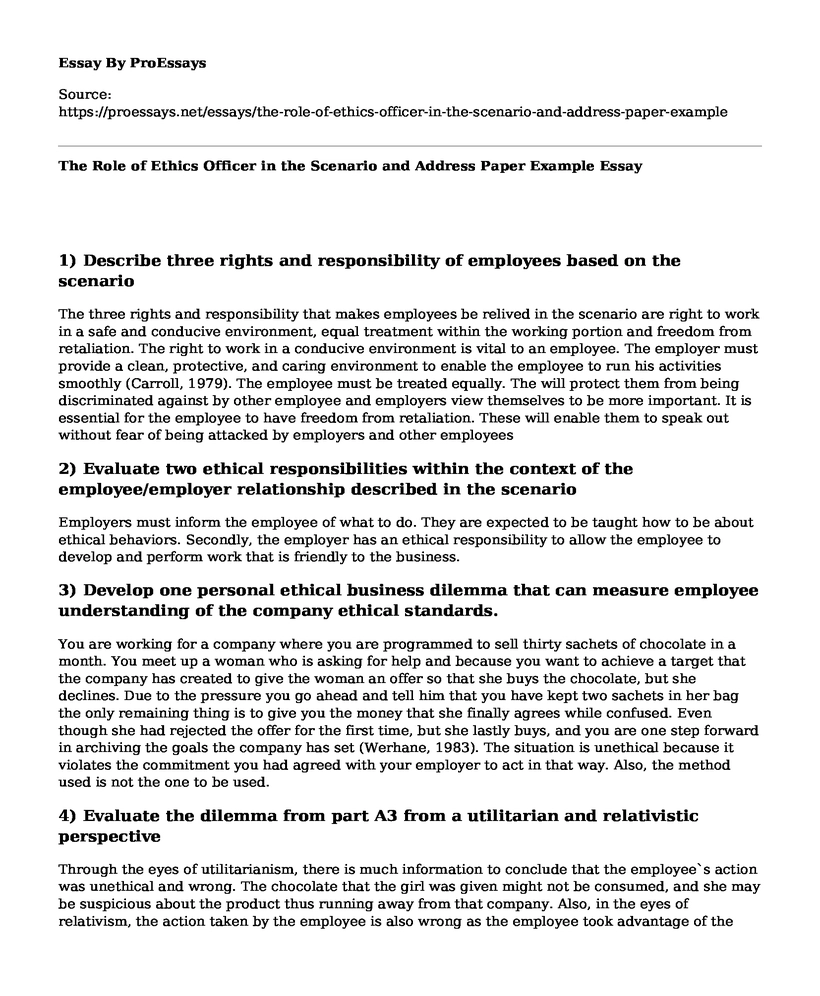1) Describe three rights and responsibility of employees based on the scenario
The three rights and responsibility that makes employees be relived in the scenario are right to work in a safe and conducive environment, equal treatment within the working portion and freedom from retaliation. The right to work in a conducive environment is vital to an employee. The employer must provide a clean, protective, and caring environment to enable the employee to run his activities smoothly (Carroll, 1979). The employee must be treated equally. The will protect them from being discriminated against by other employee and employers view themselves to be more important. It is essential for the employee to have freedom from retaliation. These will enable them to speak out without fear of being attacked by employers and other employees
2) Evaluate two ethical responsibilities within the context of the employee/employer relationship described in the scenario
Employers must inform the employee of what to do. They are expected to be taught how to be about ethical behaviors. Secondly, the employer has an ethical responsibility to allow the employee to develop and perform work that is friendly to the business.
3) Develop one personal ethical business dilemma that can measure employee understanding of the company ethical standards.
You are working for a company where you are programmed to sell thirty sachets of chocolate in a month. You meet up a woman who is asking for help and because you want to achieve a target that the company has created to give the woman an offer so that she buys the chocolate, but she declines. Due to the pressure you go ahead and tell him that you have kept two sachets in her bag the only remaining thing is to give you the money that she finally agrees while confused. Even though she had rejected the offer for the first time, but she lastly buys, and you are one step forward in archiving the goals the company has set (Werhane, 1983). The situation is unethical because it violates the commitment you had agreed with your employer to act in that way. Also, the method used is not the one to be used.
4) Evaluate the dilemma from part A3 from a utilitarian and relativistic perspective
Through the eyes of utilitarianism, there is much information to conclude that the employee`s action was unethical and wrong. The chocolate that the girl was given might not be consumed, and she may be suspicious about the product thus running away from that company. Also, in the eyes of relativism, the action taken by the employee is also wrong as the employee took advantage of the girl to sell the product to her.
5) Describe two common ethical decisions that the employees may face and develop potential action to test their understanding of corporate ethics and responsibilities
Product sold must benefit the three parties, but the situation does not accept it to happen.as an ethical officer a superb way to increase understanding of the ethical responsibility is by providing training. Also, by identifying situations and relying on values to provide the way for an employee to proceed with. Another ethical decision made by employees is that of full disclosure. The employee will be protected from making their own ethical decision setting rules between the company and the employee.
6) explain why each ethical decision in part A5 present an ethical dilemma and how an individual might justify unethical behavior
The decision on what to do if the three parties do not mutually benefit is an ethical dilemma. Without proper agreement and guidance, it is possible for an employee to take into consideration his or her perspective (Maignan, 2001).
The decision on what is best to share with a customer when selling a product is an ethical dilemma because the employee knows the ability to sell the goods is linked to the customer who is willing to buy the product. If a product is too expensive and does not meet the condition of the buyer, a line is created and an agreement will be established hence buying the product.
References
Carroll, A. B. (1979). A three-dimensional conceptual model of corporate performance. Academy of management review, 4(4), 497-505.
Donaldson, T., Werhane, P. H., & Cording, M. (1983). Ethical issues in business (pp. 153-165). New Jersey.
Frey, B. A. (1997). The legal and ethical responsibilities of transnational corporations in the protection of international human rights. Minn. J. Global Trade, 6, 153.
Maignan, I. (2001). Consumers' perceptions of corporate social responsibilities: A cross-cultural comparison. Journal of business ethics, 30(1), 57-72.
Cite this page
The Role of Ethics Officer in the Scenario and Address Paper Example. (2022, Jul 07). Retrieved from https://proessays.net/essays/the-role-of-ethics-officer-in-the-scenario-and-address-paper-example
If you are the original author of this essay and no longer wish to have it published on the ProEssays website, please click below to request its removal:
- Nature Vs. Nurture Essay
- Managerial Issues of RLK Paper Example
- Essay Sample on Managing Emergencies and Crisis
- Paper Example on People's Identity Construction on Social Media Platforms
- The 4 Leadership Theories in Organizational Management - Essay Sample
- Essay on Nurse Educators: The Driving Force Behind Skilled Nursing Professionals
- Paper Sample on Diversify Investment: Corporate Strategies for Risk Management







